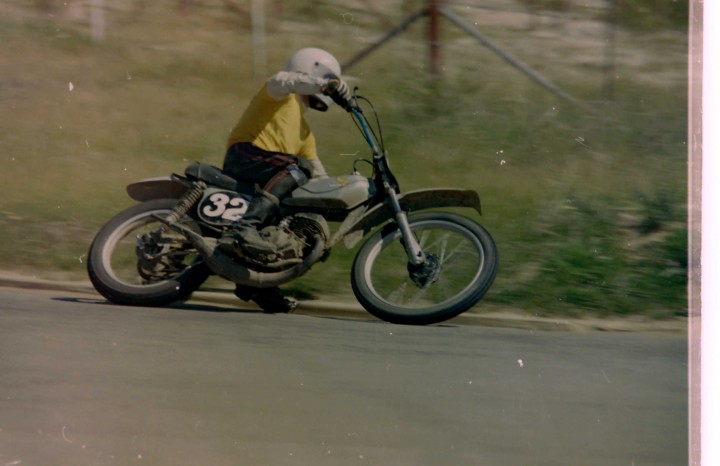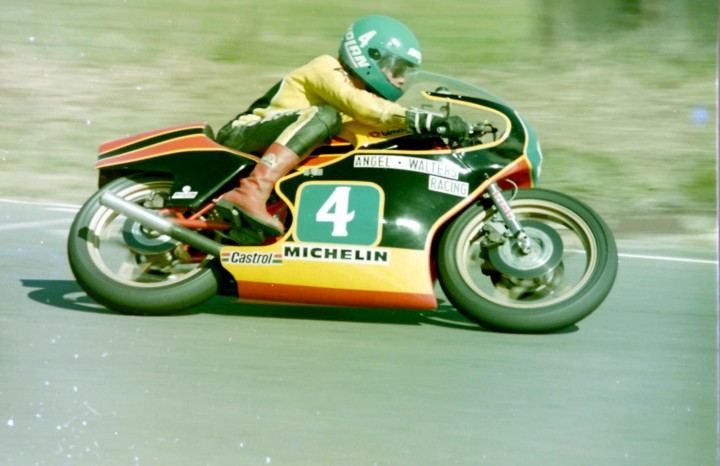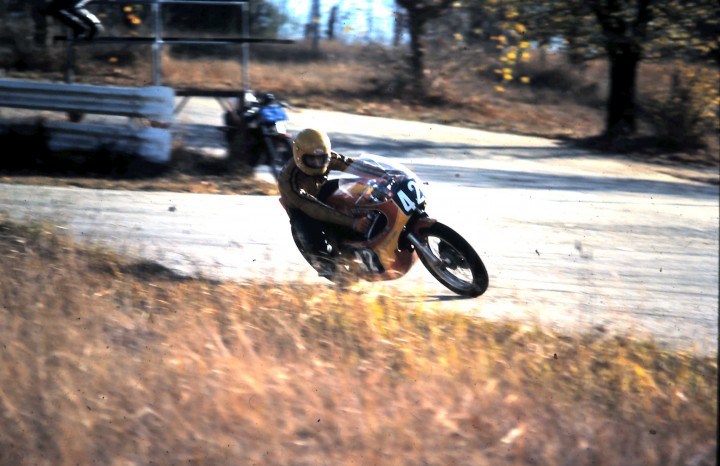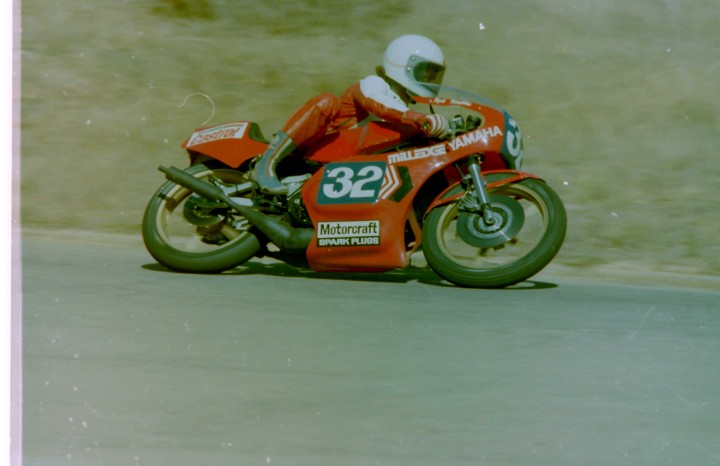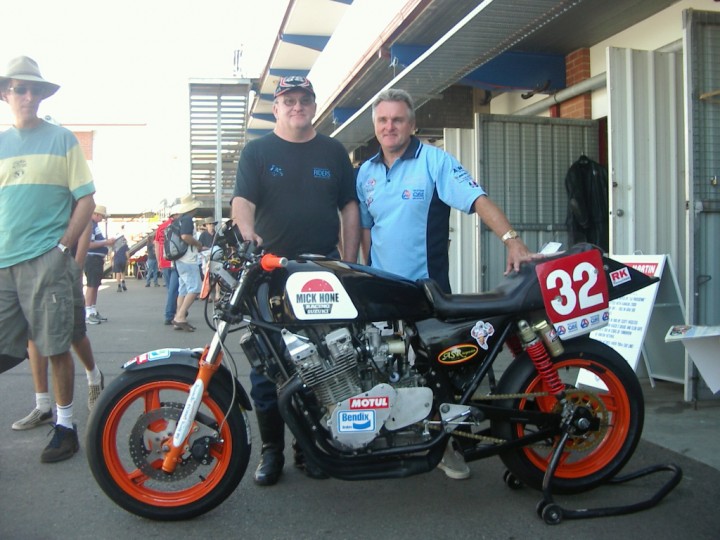Connections…. A tale of three riders, with Phil Hall
This week I want to share a little retrospective about three road racers who are loosely connected, not just by time but by location as well. The different paths that their lives took and the places that it took them are revealing for more reasons than just the racing they did.
The first one is Ron Boulden. Who? you might say, and you’d be entitled to do so. Ron burst onto the racing scene in 1976, riding an immaculate TZ350 in a British-built Maxton frame.
It was immediately apparent from the first time that I saw him at Albury’s Hume Weir circuit that here was a rider of extraordinary talent. Riding at a track which he had never seen before, he was smooth, fast and won most of his races right out of the box. Catching up with him in the pits began to reveal more of the story. As the year went by, he was upgraded, first to “B” Grade and then, at the beginning of 1977, to “A” Grade, at the time the youngest age at which a rider had ever achieved that goal. And he was still just 17 years old, we were told.
Ron’s racing was financed by a hard-working father, a security guard working bulk overtime at Sydney’s Kingsford Smith airport and run by his mother, a garrulous and intensely focussed woman whose goal was to propel her son to the top, come what may. Mentored by former Australian grand prix campaigner, Jack Ahearn, it was a formidable team. Moyna (Ron’s mum) was the driving force, not only off the track but on it as well, getting her hands dirty in the pits assisting the mechanics and doing whatever it took to ensure that her son had every possibility of success.
With results came good sponsorship, firstly from the motorcycle trade and finally from the corporate sector with a lucrative deal to head up Yamaha’s quasi-factory team in Australia. A TZ500 and a TZ750 were at his disposal as well as a company-supported bike in the Castrol Six Hour Race at Amaroo Park. Results came a-plenty, Ron and Moyna travelling all over Australia chasing championships and race wins. Along with other luminaries of the day, Vaughan Coburn, Graeme Macgregor and Ray Quincey, Ron was widely tipped as the next big thing.
Ron’s moment of glory came at Bathurst in 1979 where, riding the Toshiba Yamaha Dealer Team TZ750, he won one of the most intense battles ever seen on the mountain eventually defeating the Kiwi hero, Graeme Crosby, on the TKA Kawasaki KR750 and fellow Kiwi hero, John Woodley on the RG500 Suzuki.
It was assumed that Ron would join the exit of the late 70′s-early-80′s where many of Australia’s brightest and best rides headed to the UK and Europe to further their racing career, but Ron didn’t. Thoroughly schooled by his mother that, if he was going to race it had to be financially worthwhile, Ron decided to stay at home. Further, Moyna had always impressed on him that he had to ensure his financial security post-racing, something to which most riders gave precious little thought in those days so Ron began looking at business opportunities even while his racing career was still in progress.
But cracks were starting to appear and a scandal was narrowly averted when it became known that Ron’s dad, in an effort to get his protege onto the track as early as possible, had faked his birth certificate and that Ron was, in fact, a year younger than what he had always claimed to be. Some quick mathematics then deduced that he had, in fact, been upgraded to “A” Grade when he was only 16 years old, an age at which he shouldn’t have been road racing at all under the regulations of the day. It was never fully clarified how they were able to escape sanction for this flagrant breach of the law.
Soon after, Ron retired from racing, having never really achieved what most (including me) believe to have been his true potential. By this stage he was heavily involved in his business ventures and it was here that things took an ugly turn. A few years later it emerged that the business was in breach of all manner of corporate laws and that Ron himself, had been committing many criminal acts in order to make a considerable fortune. Worse still, it also emerged that he had conned some of his best racing mates out of huge sums of money in the process.
It was an ignominious end. Whether Ron actually served time or not is a matter on which nobody seems to have a definitive answer, but whether he did or not, his name and his achievements have been forever tainted by the dishonesty of his dealings and his career stands as a reminder that the line between good and evil is a narrow one and we cross it at our own peril. As one who championed Ron’s cause from Day 1 and was intimately connected to his early racing efforts, to say that I felt betrayed is to put it mildly. The story of Ron Boulden is truly a story of an extraordinary talent wasted. Where is Ron Boulden now? I haven’t got a clue and, to be honest, I don’t care.
The second rider is Graeme Geddes. Graeme hailed from Albury and it was here that I saw him race for the first time. On a brand new TZ350 he was awesome to watch, wickedly fast, clinical in the traffic and seemingly able to make the bike do things that others could not. It was obvious that here was an exceptional talent. It didn’t take long for Graeme to get noticed and he quickly came under the wing of noted entrepreneur, Ron Angel, the man who had guided the early career of the late Kenny Blake. Together with motel owner, Jack Walters (also a long-time supporter of Blake), they formed the most formidable of teams. Wins seemed to come with ease to Geddes who didn’t even seem to work up a sweat as he swept the best Australia had to offer before him.
Soon he was riding what many regard as being the best TZ350 ever to race in this country, a Yamaha two stroke engine in an Italian Bimota frame, and what a jewel of a bike it was.
It is said that every nut and bolt on this bike was made of titanium, replacing the mild steel items that were stock in order to save weight and increase performance. And Ron Angel, Graeme’s mentor, told me that Geddes was the most extraordinarily talented rider that he thinks Australia has ever produced.
So, where is Graeme Geddes now? I have no idea. Like most of the hotshoes of the late 70′s-early 80′s, Graeme went to England in search of fame and fortune and, like most of his countrymen who had done the same, he found that talent alone was not enough. It required vast amounts of money and, more importantly connections. Ron Angel had the connections but they didn’t connect enough and, after being discouraged one too many times, Graeme packed in the European campaign and headed home.
So, why didn’t he succeed? The talent was certainly there, and the connections were better than some other Aussie riders had and they made a good career out of following the circus. Well, it is said that Graeme became far less focussed on his racing and far more focussed on having a good time with all the temptations that were presented to a young, impressionable man during that era. To be honest, I don’t know, but what I do know is that Graeme returned to Australia, turned his back on road racing and just vanished from the scene.
The third rider’s name is Robbie Phillis. Born and raised, like Geddes, in Albury on the NSW/Victorian border, Robbie’s dad worked at Albury airport. One too many indiscretions on the airport runway on his motorbike saw Robbie heed the suggestions of older and wiser heads and take his enthusiasm for motorcycling to the track. Fortunately for Robbie, he was able to get in lots of practice at Hume Weir, the local track, as the local car club owned the track and keys to it could be obtained if you knew who to ask. Riding his 125cc Honda Elsinore motocross bike he terrorised the locals until he purchased a brand new TZ350.
I first saw Robbie at the same “C” Grade day at Hume Weir where I first saw Ron Boulden race. This photo was taken that day. Robbie had taken his TZ to the track the Wednesday before this weekend and had crashed it three times but, come race weekend, it was repaired and he raced it against Boulden and the two shared the wins, Robbie coming out on top by winning the Feature Race at the end of the day. As with Boulden and Geddes of course you have already figured that the connection between the three is the Hume Weir circuit. Phillis was obviously talented but, unlike the other two, smoothness and civility were not part of his racing makeup. Son of hard-working locals, Robbie scrimped to go racing and never attracted a major sponsor until later.
But was he fast? Hell, yes he was, although ragged and with a propensity for having horrendous crashes. Given a bike to ride by Colin O’Neill of Malvern Motorcycles, Robbie was almost the death of Colin, trashing his valuable racing bikes with regularity. He branched out into Production racing as well as the emerging Superbike class. In a year of riding as a sponsored rider for the Victorian Yamaha distributors, Milledge Yamaha, he almost came to blows with his equally hot-headed team mate, the late Andrew Johnson. It was a disaster with team politics causing many a bitter argument.
But then, just as it looked like Robbie had burned every bridge possible, a saviour appeared in the person of fellow Victorian racer, Mick Hone. Hone had opened his own bike shop after running bikes for many years for the Peter Stevens organisation and he offered Robbie a ride on his GSX1100 superbike. Many a wise head was shaken as we wondered if Mick was going to be able to afford to keep fixing Robbie’s bikes, but the transfer to the Hone team seemed to have had an astonishing effect on the young tear-away. Many of us at the time believed that Mick had taken Robbie into the back of the workshop one day early in the relationship and had threatened him with all manner of mayhem if he did to HIS bikes what he had done to Colin’s. That probably didn’t happen, but, whatever DID happen transformed the ragged and unpredictable Phillis into a smooth, cunning, calculating and brutally efficient racer.
Four consecutive Australian Superbike Championships followed with nary a mark on the bikes to show that they had even been raced. Phillis was peerless, untouchable, not even his old nemesis, AJ, could beat him, despite being mounted on the ferocious Syndicate Kawasaki. If Phillis turned up at a meeting, he won. He made the transfer from the “sit-up-and-beg” superbikes of the 70′s to the streamlined weapons of the 80′s with nary a blip and it came as no surprise when Robbie also followed the trend and headed overseas. And what a success he made of that. A frontline competitor in the early days of the World Superbike Championship, riding for Kawasaki, in the 1991 and the 1992 titles he finished 3rd overall and his WSBK CV boasts 4 wins, 23 other podiums, 3 poles and 6 fastest laps. Not bad for a boy from the bush.
Returning to Australia, Robbie continued to race until he retired in 1998 at age 42. But his retirement didn’t last long. Enticed from the comfort of retirement by the thrill of racing and the fun that he knew he could still have, Robbie returned, this time focussing on Post Classic racing. Racing the very same GSX1100 with which he had won 4 titles in the early 80′s, Robbie romped to championship after championship, as dominant on the track and gregarious off the track as he had ever been.
I’m proud to say that I count Robbie as a friend. Our paths cross regularly at race meetings and I can always be sure of hearing his gravelly voice saying “What are you doing here, Hally?” at some stage during a meeting. Robbie has now retired the old girl and races a Katana and is still a race winner, aged now 56 years old. An adornment to the sport and a living legend, his name is revered throughout Australian racing and overseas. Robbie’s mantle has now passed to his son, Alex, who Robbie is mentoring into a rider with a good career as a road racer in front of him.
Thanks to Martin Halford for this wonderful shot of Robbie from Hampton Downs last weekend.
So, a tale of three riders, all connected and all with a fascinating story. I hope you’ve enjoyed reading about them.
